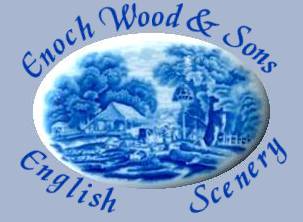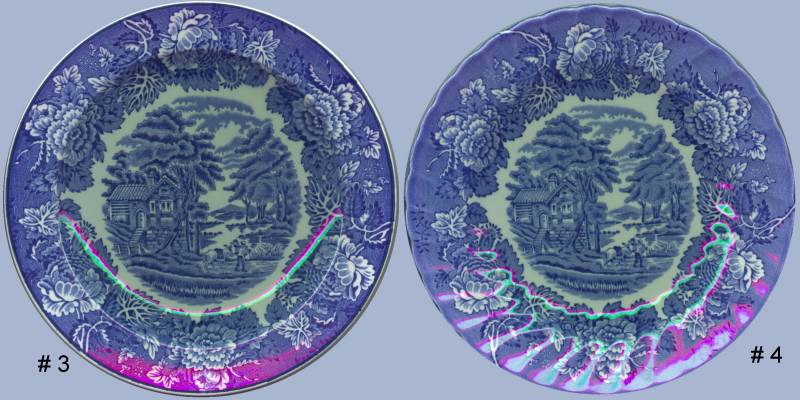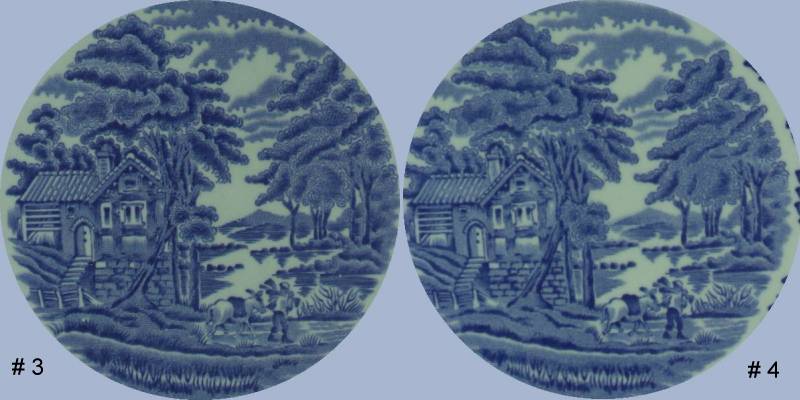




A comparison of Enoch Wood's, English Scenery's different manufacturing periods.
As I mentioned on the previous page, there are some very distinctly noticeable differences in the artistry of the pattern over the many years it's been being manufactured. While I'm still trying to find out just how long a time span we're talking about, or exactly how many distinct design periods there are and their through-dates, I have been able to isolate at least four with 100% cetainty.
I offer the following comparison's of an Enoch Wood & Sons, English Scenery salad plate. I'm comparing four different salad plates here, with # 1 being the oldest, then #2, then #3 and finally, the most recently made, #4.
First I ask you to look at the plates themselves, which started quite thin and became progressively thicker.

There's no mistaking the difference between these first two plates. The older of the two (#1) not only has several differences in the picture itself, it also shows that the artist had a far finer hand than his copying successor. This is most noticeable in the leaves of the trees. The older plate is also quite a bit thinner than the next oldest one.

Once again, plate # 3 has a much different picture than plate number 2. It's thicker still, and the drawing style becomes even more broad. Plate #4, the newest of the four, has very few changes in the picture itself to that of it's immediate predecessor, but has taken on a scalloped edging.
![]()
Next, let's compare the back markings of the four plates.

There are differences to be seen between the back markings on each of these plates, the 4th having the most obvious difference. This one really surprised me. The fact that it's microwave and dishwasher safe tells us that these have been made quite recently. You'll notice however, that the E.W. logo is gone, as is any mention of Enoch or Ralph, or even the name 'Woods Ware'. The differences between the first three are more subtle, but still obvious enough that I don't think I need to point them out. I'll let the pictures speak for themselves. I might also mention here, that most of the oldest pieces also have a colorless number and/or other unreadable mark stamped into the back of the plate.
![]()
Before I get to the fun part, that of comparing the pictures themselves, let me place the focus on the rim designs.

The rims are probably the most tell-tale of the different manufacturing periods. I've never seen any of the 10" plates with border #1, and am of the mind that they weren't part of the original design. If someone can prove me wrong, please do let me know! On the previous page I state my belief that the pattern has changed over time, but not evolved, if to evolve truly means to adapt for the better. I much prefer the rim of #1, then I'd choose # 2. I find nothing remarkable about #3 and I don't really care for #4 at all. I hope to sell those #4 pieces I've mistakenly acquired.
![]()
Now let's look at the center pictures themselves.


Numbers 3 and 4 and essentally the same. The fact that # 4 has scalloped edges and is microwave and dishwasher safe is what sets it apart so clearly. There is however, markedly different featues in the design of the first three. Let's take a closer look at some of the details .
![]()
First I draw your attention to the figures as the focal points.

On plate#1, we seem to have someone (a woman?) sitting on a horse
or donkey, with a man standing next to them. They're stopped on a
narrow foot path. In the second plate, The animal no longer has
anyone sitting on him but is carrying a load of some sort. The
man is no longer standing idly by. Now He's marching forward, on
a path that has gotten wider and, it would appear, more traveled.
(Certainly more muddy.) He walks in front of his beast, with a
load of his own slung over his shoulder. On the 3rd and 4th
plates, the man has his back to us and has changed his clothes to
what I believe is a somewhat more modern clothing style. I'm sure
you can spot several other differences also.
![]()
Next let's look at how the
house has changed.

The house on plate #1 is seen from a different angle, and is a different house than that seen in the later 3 plates. The later houses are built on a hill with steps leading up to the front door and a stone wall fortifying the right side foundation. (Or perhaps that is the foundation). The house on plate#1 also appears to have an older architectural design, having a more Tudor feel to it. It certainly has more chimneys. The house on plates 3 & 4 are very similar to the house on plate #2, but some obvious differences between them are seen. (I'd rather live in the house on plate #1) ;-)
![]()
Next let's look at what I'm calling the center vista.

The pattern design has lost varying levels of it's fineness of detail with each copying/manufacturing period. The leaves on the tress on plate # 1 are drawn more delicately, with a finer level of detail than they are on plate#2. The same can be said for plate#2 when comparing it to plates # 3 & #4. The weather even seems to have changed. We start with a misty day and the weather appears to get progressively clearer.
![]()
The final area of detail I offer up for comparison is the lower-left corner of the center picture.

![]()
This comparison was done on the salad plates, aproximately 7½" in diameter. The same kind of comparison could be done on any of the other pieces with similar results.
I've also noticed a definite difference in the lid knobs and handles on various pieces. I'll save that for another page. I'm anxious to get to it, because my own old set has a sugar bowl unlike any I've seen elsewhere. It has the deep blue knob, but it isn't slanted or made to ressemble a berry as some of the later piece's knobs have been.
If you can offer any new insights, please do. As I've stated, I created this page because I couldn't find any other page on the interenet, or any of the transferware books I've looked in, that discusses this pattern. I'm anxious to assemble all the information I can find about it here. With luck, the next time you stop by for a visit, there will be more to tell.
![]()
If any viewers have information on the history of this pattern,
or any information at all on it, please contact me at : LaPiers@msn.com .
Thanks! KathyL
Copyright © LaPier Web Designs, 1999-2002
All rights reserved.